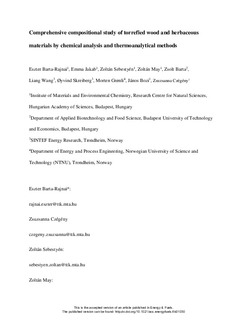| dc.description.abstract | In this work, the torrefaction of three biomass materials, black locust wood, wheat, and rape straw, was studied at various temperatures: 200, 225, 250, 275, and 300 °C. The thermal stability and formation of the decomposition products of the untreated and treated samples were measured by the thermogravimetry/mass spectrometry method. The degree of hemicellulose and cellulose decomposition during torrefaction at different temperatures was characterized by compositional analysis of the torrefied and untreated samples. The cellulose, hemicellulose, and Klason lignin contents of the raw and torrefied biomass samples were determined by acidic hydrolysis and subsequent high-performance liquid chromatography analysis. The inorganic ion contents of the untreated samples were measured by the inductively coupled plasma optical emission spectrometry method. The joint evaluation of the results obtained by various analytical methods revealed that the acidic side groups of hemicellulose were partially split off, while the main mass of hemicellulose did not degrade at 225 °C torrefaction temperature. About 40% of hemicellulose degrades at 250 °C torrefaction temperature and the remainder decomposes at a higher temperature. Although hemicellulose has a different chemical structure in the hardwood and straws, no significant differences were observed in the thermal stability of hemicelluloses in the three studied samples. When the significantly higher alkali ion content of the straw samples is taken into consideration, it was concluded that the alkali ion content of the samples did not modify the thermal stability of hemicellulose. Statistical analysis [principal component analysis (PCA)] has been used to present correlations between the torrefaction temperature, chemical composition, and thermal parameters of the samples. The PCA calculations revealed substantial changes in the chemical composition and thermal properties of biomass materials as a result of torrefaction at 275–300 °C temperatures. | |
